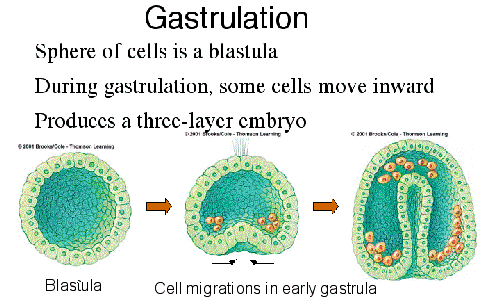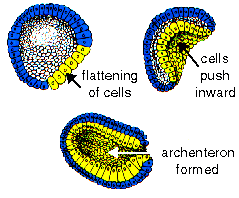The three layers of the embryo are
- Endoderm
- Ectoderm
- Mesoderm

During gastrulation, three major cell lineages are being established. They are the Ectoderm, Mesoderm and Endoderm. Following gastrulation, various cell lineages are derrived from these three primary cell types. For example, the Ectoderm gives rise to the epidermis and its derrivatives such as nails, hair and teeth. On the other hand, the Ectoderm also gives rise to the Central Nervous System.
Gastrulation
“It is not birth, marriage, or death, but gastrulation, which is truly the most important time in your life.”
Lewis Wolpert (1986)
 During gastrulation, cell movements result in a massive reorganization of the embryo from a simple spherical ball of cells, the blastula, into a multi-layered organism. During gastrulation, many of the cells at or near the surface of the embryo move to a new, more interior location.
During gastrulation, cell movements result in a massive reorganization of the embryo from a simple spherical ball of cells, the blastula, into a multi-layered organism. During gastrulation, many of the cells at or near the surface of the embryo move to a new, more interior location.
The primary germ layers (endoderm, mesoderm, and ectoderm) are formed and organized in their proper locations during gastrulation. Endoderm, the most internal germ layer, forms the lining of the gut and other internal organs. Ectoderm, the most exterior germ layer, forms skin, brain, the nervous system, and other external tissues. Mesoderm, the the middle germ layer, forms muscle, the skeletal system, and the circulatory system.
Scientists
Pander, Christian (1794-1865) was the Russian zoologist who studied the chick embryo. He discovered the three layers that form in the early development of the embryo, and is considered the father of embryology. Pander’s work was extended by Baer.
Remak, Robert (1815-1865) was the German physician who is the founder of electrotherapy. He also reduced the four germ layers of Baer to three and gave them their modern names of ectoderm, mesoderm, and endoderm. Remak devised a cellular interpretation of vertebrate development.
© 1996-2007 Eric W. Weisstein






























